In 2011, I left Seattle with just $200 in my pocket to travel the world solo. Today, I'm the founder and creator of The Solo Girl’s Travel Guide, the #1 travel guide book series for women - and the author of The One-Way Ticket Plan.
Meet Alexa
this book has magic powers
The Best Selling Travel Guide Book Series for Women
Join my weekly newsletter - Solo Girls Stories - and learn to travel smarter via my wild mistakes.
Travel Cheaper, Smarter, Safer, and Longer.
Building an Agency, Creating a Brand, Digital Nomads, Expat, Freelance Work, How To, Making Money, Photography, Remote Work, Travel Paths, Travel Tips
How To Create a Brand and Monetize It

Hey! I’m Emilia, I’m Alexa’s #TravelBFF but I’m also a brand designer and I’ve been helping people create their dream brands for the past 10 years. I’m taking over this blog (or at least this post) to share with you how you can create a successful brand yourself, and how you can monetize it!
But first things first…
Jump to...
What is a Brand and why do you need one?
A brand is the way you’re going to communicate who you are. Whether you’re an artist, a candle maker or a lawyer…your brand is the lighthouse that will attract the people who align with what you do and that are in need and want of your magic.
Most people think that branding is just a logo, some colors, and fonts. But in reality, branding is much more complex than that. Branding is your business’s personality and story. Your mission and vision and how you interact with customers.
Why do you need it?
Branding will allow you to establish and position your business and differentiate it from others in your industry. It will also help you create a memorable impression on your potential customers and foster loyalty. And finally, good branding can impact your financial success. A well-rounded and polished brand will create a better user experience and so, more impact and more sales!
But I’m just creating my personal brand, do I still need branding?
Yes, yes, you do. And this is really important because personal brands are the future!
How let’s dive into how to create your brand…
10 Steps to creating your Brand

1. Define Your Mission
Your Brand’s purpose and mission is the reason your brand and business even exists. And while most people will teach you that your mission should be simple, I believe it can be layered.
For me, there’s the practical approach to it, and the inspirational approach. Or what I like to call: Making an income while making an impact.
Your mission should be not only what you or goals are, but your why. Why do want to start a brand? What drives you? Start there.
2. Define your Soulmate Client
You could have the most visually-striking branding, the clearest message with the most killer copy, but without knowing who your ideal client is, it would be like having a blunt sword. Pointless…literally.
Why? Because teenage girls don’t speak the same language as 60 year-old grandmas. You need to speak the language of who you want to reach. And also, knowing who you’re talking to is going to allow you to choose the right channels. If you want to reach an older crowd, chances are they are not on TikTok, for example.
So we’ve got to figure out who your soulmate client is, aka, who you’re doing this for.
Identify your soulmate’s clients demographics…
Gender:
Age:
Marital Status:
Location:
Profession:
Economic Status:
Now let’s paint a picture. What are they like? What do they like? How do they spend their time? What does their day look like? Imagine this person. You even give them a name and imagine you’re talking to them every time you’re creating content, copy or even new services/products.
3. Know your Competition
Positioning is differentiating your brand from your competition, so it can reach a key place in your target audience’s mind. So it’s important to know who your direct and indirect competition are.
What is your competition doing? What do you admire about them? What can you learn from them? What can you do different or better?
Remember: We analyze our competition to see what we can learn from them and identify our unique selling points. But there’s enough room at the table for everyone, and we should continue working towards a culture where small businesses support each other!
4. Identify your Key Differentiators
In short: What’s your superpower?
Your key differentiators are your unique selling points that will set your brand from your competition. It can be the way you operate your business, the fabrics you use, the kind of content you create…the things that you do in a different, unique and special way.
5. Craft Your Brand Story Formula
Now it’s time to put everything together and craft your Brand Story Formula, a short statement that encompasses what you do and who you do it for. Pretty much like an elevator pitch…
Brand Story Formula:
My clients are…
who struggle with…
and feel…
My brand helps them…
by doing…
so they can finally…
Let’s take Alexa for example:

Her ideal client is Shelby, a girl from Ohio who has never left the States. Shelby wants to travel solo to Cambodia, but she is afraid of doing so. Alexa is solving her problem by creating a guidebook that contains everything a solo female traveler should know about certain destinations, and that is filled with solo-female-friendly destinations. This guidebook makes Shelby feel safe and confident to go on her trip.
So Alexa’s clients are girls who want to travel
But struggle with the fear of traveling alone
and feel frustrated and stuck
Her brand helps them face the fear
by creating travel guides, tools and resources
so they can finally take the step and travel solo!
Now your turn!
REMEMBER: YOUR BRAND’S STORY IS ABOUT YOUR CLIENT, NOT ABOUT YOU
6. Choose Your Brand Values

Your Brand Values are exactly that: your core values. What your business believes in and stands for. They will serve as guidelines for how your business operates.
If one of your Brand Values is sustainability and you have a clothing line, for example, then you’ll probably opt for non-plastic packaging. Or, if you’re a fashion content creator, you’ll choose local brands that use eco-friendly fabrics over fast-fashion labels.
Choose 3-5 values to be your brand’s compass.
7. Define Your Brand’s Personality
Just like people, a brand has a personality. Some brands are more serious, others are funny and humorous. It’s important to know the personality of your brand because this will determine how you brand will look, feel and communicate.
Choose 5 words that represent the personality of your brand.
Then choose 5 words that don’t represent it. It’s also important to know what your brand is not. If your brand’s personality is luxurious, then it’s probably not going to be silly and irreverent.
8. Create Your Visual Branding
Good news: You don’t have to create a highly complex or professional logo and visual branding, especially when you’re starting out.
Nowadays there are tools available for you to D.I.Y. your own visual branding without having to spend thousands of dollars in professional design. This is extremely helpful when you’re starting a new business.
However, I highly recommend hiring a professional if you can. Especially if your business is going to need a lot of printed items like menus, signs, or uniforms.
That being said, Canva is your new best friend. If you’re not familiar with Canva, it is an online platform that allows users to create visuals and graphic in an incredibly user-friendly way. It has a very wide library of templates, graphics, photos and videos available and it has both free and paid subscription options.
So Canva is where you will be creating anything visual for your brand. Starting with your visual branding.
8.1 Get inspired
Whenever I’m going to start working on a new brand, my first step is to search for inspiration and create a moodboard, a visual compilation of images that inspire me and help me visualize what I want the brand to look and feel like.
Remember: Being inspired by other brands is part of the process, but there’s a line between inspiration and copying someone else’s work!
8.2 Color palette

People don’t choose brands because of how they look but because of how they make them feel. And colors are one of the main tools to generate emotions in a brand.
Use this list of colors and their meanings to assemble your color palette, and don’t forget to cross-reference with your Brand’s Personality…
- PINK / tenderness, compassion, empathy, softness, love, affection
- RED / energy, strength, power, desire, love, determination, danger
- ORANGE / creativity, optimism, energy, joy, enthusiasm, determination, stimulation
- YELLOW / joy, sunshine, happiness, freshness, creativity, bright, warmth, warning
- GOLD / luxury, wealth, power, wisdom, tradition, spirituality
- BROWN / dependability, resilience, earthy, stability, wisdom, honesty
- GREEN / kindness, balance, natural, freshness, harmony, growth, calm
- BLUE / intellect, serenity, peace, healing, uniqueness, authenticity, loyalty
- PURPLE / royalty, nobility, spirituality, magic, mystery, luxury, intuition
- GRAY / classic, timelessness, versatility, luxury, minimalism, harmony, security
- WHITE / purity, goodness, innocence, cleanliness, perfection, freshness, imagination
- BLACK / timelessness, elegance, power, formality, mystery, prestigious, dark
You can also pay attention to the colors that show up in your mood board.
8.3 Font Selection
Fonts are also an important way to convey the personality of your brand. Some fonts are casual, while others feel more formal. S
And some can be used to add a fun touch to your brand.
This article from Canva is really helpful to understand the psychology behind fonts and choose the right one!
And please, whatever you do stay away from Comic Sans.
8.4 Logo
Lots of people think a logo is synonym for a brand, but, while the logo stands front and center, it won’t really go anywhere without everything we’ve talked about so far.
Making your own logo might feel daunting, but follow these 3 simple rules and don’t over-complicate it.
Rule #1: Less is more. Stay away from complicated logos with tons of elements. A logo should be easy to read at a glance!
Rule #2: Stick with solid shapes. Avoid elements like water color splashes (you can use those as sprinkles in your brand, but not as a logo!)
Rule #3: Make sure your logo works in black. Just black. Then, add color.
9. Your Brand’s Voice

Think back to your Brand’s Personality…now how would someone with that personality speak? What kind of world would they use?
Your Brand’s Voice will determine the kind of words and tone you will use for your Brand’s communication, whether it’s in your Instagram captions, your website or newsletters. Will that voice be formal? Or will it be friendly? Will you use emojis or will you keep it serious?
10.Stay cohesive!
Your brand is ready, and now it’s time to dress up your different channels. Make sure you have the same profile picture across your social media channels, and that you’re using the colors and fonts you chose for your brand. Keeping cohesiveness across your different platforms is key to position your brand and to keep it clear and memorable.
How to Monetize Your Brand
Maybe you’re starting a brand because you already have a product or service in mind, or maybe you’re starting a brand but are not sure how to monetize it. Either way, there are so many ways to monetize a brand, even more than the ones we’d think!
Here are 8 ideas of how to monetize your brand…
1. Sell physical products
2. Offer your services
3. Create a course or masterclass
4. Offer a monthly subscription
5. Create digital products
6. Seek out Brand Collaborations
7. Affiliate Marketing
8. Display ads in your website / blog
Find the right ones for your brand and don’t forget to diversify! Stay open to new ideas and ways to create income.
Remember: there is no golden ticket to monetizing a brand over night. The same way a business doesn’t become successful in one day. It takes time, passion and consistency to build and grow a brand.
And that’s it! This was one lengthy post, but now you’re fully equipped to embark on the adventure of creating your brand. If you need some help shaping your ideas, I’m happy to say that brainstorming is my superpower. Book a call with me here and let’s set your dreams in motion. Or visit me on my website, HolaEmilia.com.
Happy branding!
— Emilia Igartua
The
One-Way
Ticket Plan
this book has magic powers
Find and Fund Your Purpose while Traveling the World
Want to contribute to the blog? I love to feature the perspective of other solo female travelers.
Application
Blog Contribution
I'm a bestselling author, hotel reviewer and pickleball player. I teach women how to travel the world solo without going broke or getting kidnapped.
In 2011, I left Seattle with just $200 in my pocket to travel the world solo. Today, I'm the founder and creator of The Solo Girl’s Travel Guide, the #1 travel guide book series for women - and the author of The One-Way Ticket Plan.